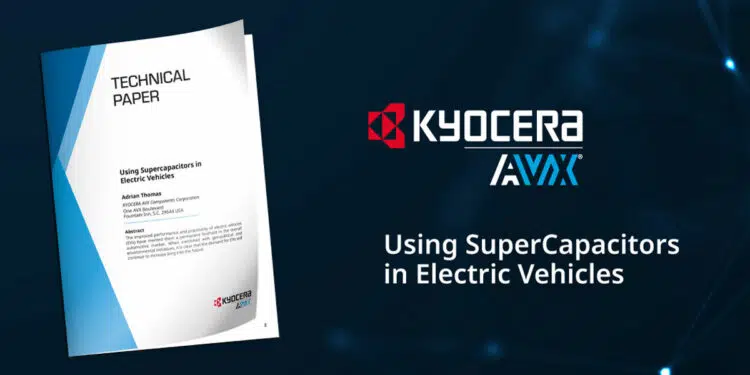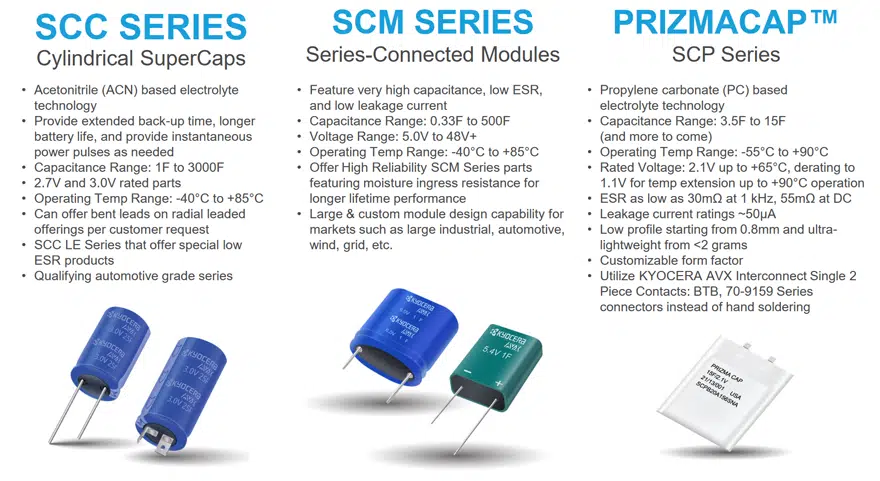This article written by Adrian Thomas, KYOCERA-AVX Components Corporation, discusses use of supercapacitors in electric vehicles.
The improved performance and practicality of electric vehicles (EVs) have merited them a permanent foothold in the overall automotive market. When combined with geo-political and environmental initiatives, it is clear that the demand for EVs will continue to increase long into the future. For example, in the United Kingdom, there are new plans that ban sales of all petrol and diesel-powered passenger cars by the year 2030. In parallel, all of the major automotive manufacturers are rushing to electrify their line-ups. Volkswagen, for example, recently released the new all-electric ID.3 (replacing the e-Golf). While this growth and rapid pace of innovation is exciting, it has created a myriad of yet to be solved challenges.
The driving range of EVs, the time required to recharge them, and the charging station infrastructure are three of the biggest problems standing in the way of universal adoption. Driving range is improving continuously as the technology evolves for Lithium-Ion (Li-ion) batteries — the dominant
mode of EV energy storage.
For example, Tesla announced in October 2020 the development of a new “tab-less” battery cell design. This design improves heat transfer performance and yields higher energy density and lower overall cost. Even though these batteries are closing the fossil fuel gap on range, they still suffer from limited temperature tolerance, long charging times, and charging cycle wear out. When combined with the relative immaturity of charging infrastructure, the resulting “range anxiety” is a very real barrier to consumers switching to EVs.
The Benefits of Supercapacitors in EVs
One alternative to the chemical battery for storing electrical energy is the supercapacitor. These devices are composed of electrodes, an electrolyte, and an ion-permeable separator. Energy is stored using an esoteric phenomenon known as the electrical double layer, demonstrated by Hermann von Helmholtz in 1853. Though the energy density of supercapacitors is 10 to 50 times lower than Li-Ion batteries, they offer several unique characteristics that make them attractive in EV applications.
First and foremost, supercapacitors exhibit fast charge and discharge times and have an effectively unlimited cycle life. This makes them ideal candidates for regenerative braking systems and during periods of rapid acceleration. By reducing the load on the main EV battery, its lifetime can be extended while simultaneously providing improved driving performance.
Outside of the vehicle itself, there exists a clear need to improve the charging network infrastructure and use a smart charging principle to help manage energy demand. A hybrid application of supercapacitors and batteries could be particularly beneficial in solar and wind farm applications where the available energy is unpredictable. The supercapacitors allow for a faster, more efficient means for the system to collect energy and helps to reduce stress on the batteries, improving overall lifetime and reducing cost.
Commercially available supercapacitors already span a wide range of performance metrics for automotive applications. KYOCERA AVX — a leading worldwide manufacturer and supplier of a broad line of active and passive electronic components and interconnects — offers several reliable supercapacitor options for EVs. KYOCERA AVX’s supercapacitor lineup is shown in Figure 1 and includes numerous form-factors, capacitance ranges, from 330mF to 3000F, wide temperature ranges, and low ESR.
Lastly, it’s worth noting that supercapacitors contain no hazardous materials, require no maintenance, and are comparatively lightweight. These characteristics make them well suited to automotive applications, especially with the current focus on environmental impact. By judiciously applying supercapacitors to both the vehicle side and the charging network side of the equation, the goal of completely switching to EVs becomes a more realistic scenario.
Advances in Supercapacitor Technology
On average, supercapacitors have energy densities of around 8-10 Wh/kg. The energy density is far below the 200 Wh/kg of a typical Li-ion battery. Closing the gap between the energy densities of supercapacitors and batteries has been the basis of a large body of research worldwide, much of which focuses on advanced materials and construction. Studies at Penn State University, in collaboration with two universities in China, have shown that by combining Manganese Oxide with Cobalt Manganese Oxide as a positive electrode and a form of graphene oxide for a negative electrode, high power densities and cycling stabilities can be achieved. Polyaniline is also being investigated for use in supercapacitor electrodes.
It is redox-active and can be fabricated to be highly porous, making it an excellent choice for supercapacitors. Graphene is another highly researched material for supercapacitors. It is a thin layer of pure carbon tightly packed and bonded together in a hexagonal honeycomb lattice.
It is widely regarded as a “wonder material” because it is endowed with an abundance of astonishing traits, including high conductivity and high mechanical strength. It is often suggested as a replacement for activated carbon in supercapacitors due to its high relative surface area.
The Road Ahead
Predicting where the future in EVs and charging networks is going to end up is unclear, but the march towards fully electric transportation will only intensify as government targets approach and more people adopt the technology. There will inevitably be advances in current technology that will help improve the ability for electric vehicles to go further, last longer, charge faster, become lighter, and cost less than they currently do.
Promising material breakthroughs will help the adoption of supercapacitors in automotive applications, and of these, the use of graphene appears to be the most advanced. The potential to make supercapacitors with higher power densities that are maintenance-free and reliable is promising.
This material could also result in thinner supercapacitors integrated into body panels, roof paneling, floors, and even doors. In theory, this could provide the vehicle with all the energy it needs and make it considerably lighter than battery-powered electric vehicles. Over the coming years, these technological advancements could impact the widespread adoption of electric vehicles and our ability to reach the goal of becoming fully electric in the future.































